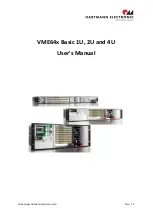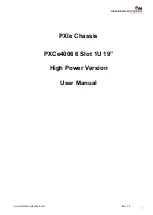
4
Issue 14, April 2003
64200376L1-5A
flange mounting holes to identify where the pilot
holes will be drilled.
3. Using a 1/16 inch bit, drill pilot holes at the marked
locations.
4. Mount the chassis using the four #8 by 3/4 inch pan-
head wood screws.
Connections.
All connections are made through
terminals, jacks, and wire-wraps on the backplane.
Refer to Figure 2 on page 2 for backplane connections.
Refer to Table 1 on page 4 for backplane reference
designator descriptions and functions supported.
A removable rear cover provides access to the
backplane, and an access panel that mounts to the rear
cover allows access to wire-wrap strips P1, P3, and P5,
power terminal strip P7, and clock termination switch
SW1 without removing the main rear cover. Most CPE
applications will not require removal of the rear cover.
Table 1. Total Access 850 Backplane Connections
UL 1950 Deployment Guidelines.
One of the
following two powering schemes shall be used when
powering this equipment:
1. Use the ADTRAN power supply (part number
1175043L2).
2. Do the following:
a. Connect the unit to a reliably grounded -48 Vdc
source which is electrically isolated from the AC
source.
b.A readily accessible disconnect device, suitably
approved and rated, shall be incorporated in the
input source wiring.
c. The branch circuit overcurrent protection shall be a
fuse or circuit breaker rated minimum 48 V, maxi-
mum 20 A.
d.This unit shall be installed in accordance with the
requirements of NEC NFPA 70.
The installation configurations codes are given below:
Alternate Connections.
For wire-wrap or screw
terminal connections, the rear cover does not need to be
removed; only the terminal access cover needs to be
removed. Make wire-wrap or screw terminal
connections as follows:
1. Unscrew the access cover hold-down screw.
2. Slide the access cover down slightly to disengage the
lock-tabs from their slots.
3. Identify the wire-wrap pins designated for use, and
make the connections starting with the pins closest to
the exit port to avoid wiring interference as work
progresses.
4. If alternate power connection to P7 is to be used,
make those terminal connections last.
5. Carefully route wiring through the exit port.
6. Position and align the access cover tabs to the slots;
insert the tabs and slide the cover up slightly until
the screw holes are aligned. Ensure that exit wiring is
not pinched or damaged.
7. Reinsert the hold-down screw.
Customer Connection.
One 50-pin female
amphenol connector (P2) provides the interconnect
wiring for the access modules located in slots 1 through
6 of the chassis. This connector is usually terminated
with a punch-down block for premises wiring or
connected directly to a cross-connect or main
distribution frame. Figure 4 on page 5 details the
connector pinout.
T1 Connection.
There are two termination points for
connecting the network T1 to the chassis: the primary
RJ-48 connector (JP2) and the alternate wire-wrap pins
on terminal strip P3 (as shown in Figure 2 on page 2).
Only one connector type is used (not both).
Ref Des
Device/Label
Technology
P1
wire-wrap strip
clock/tests
P2
50 pin amphenol
FXO, FXS, etc.
P3
wire-wrap strip
alternate T1 interface
P5
wire-wrap strip
alarms
P6
4 pin jack
primary -48 V in
P7
3-lug terminal
alternate -48 V in
JP1
RJ-48/E-NET
10BaseT Ethernet
JP2
RJ-48/T1
primary T1 interface
JP3
RJ-48/FT1
DSX1 interface
JP4
RJ-48/MAINT
RS 232 craft interface
J1
V.35
Nx56K/64K
In
Out
PC
F
C
IC
E
-
TC
X
X
CAUTION
Both Power and T1 services have two connection
points. In all cases, only one of the connection
points is used. Adhere to the instructions in the
following subsections to ensure correct installation.
CAUTION
Use wire gauge suitable for the application.



























